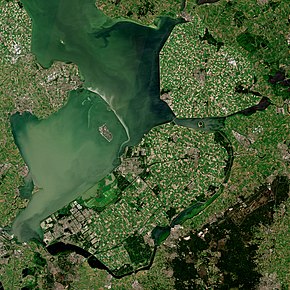
Back جزيرة اصطناعية Arabic Islla artificial AST Изкуствен остров Bulgarian Vještačko ostrvo BS Illa artificial Catalan Umělý ostrov Czech Künstliche Insel German Τεχνητό νησί Greek Artefarita insulo EO Isla artificial Spanish

An artificial island or man-made island is an island that has been constructed by humans rather than formed through natural processes.[1] Other definitions may suggest that artificial islands are lands with the characteristics of human intervention in their formation process, while others argue that artificial islands are created by expanding existing islets, constructing on existing reefs, or amalgamating several islets together. Although constructing artificial islands is not a modern phenomenon, there is no definite legal definition of it.[2] Artificial islands may vary in size from small islets reclaimed solely to support a single pillar of a building or structure to those that support entire communities and cities. Archaeologists argue that such islands were created as far back as the Neolithic era.[3] Early artificial islands included floating structures in still waters or wooden or megalithic structures erected in shallow waters (e.g. crannógs and Nan Madol discussed below).
In modern times, artificial islands are usually formed by land reclamation, but some are formed by flooding of valleys resulting in the tops of former knolls getting isolated by water (e.g., Barro Colorado Island). There are several reasons for the construction of these islands, which include residential, industrial, commercial, structural (for bridge pylons) or strategic purposes.[4] One of the world's largest artificial islands, René-Levasseur Island,[5][6] was formed by the flooding of two adjacent reservoirs. Technological advancements have made it feasible to build artificial islands in waters as deep as 75 meters.[7] The size of the waves and the structural integrity of the island play a crucial role in determining the maximum depth.[7]
- ^ Sreekumar, Kavya; Hassan, Gazi (2020). "A Study of Artificial Islands" (PDF). Centre for Public Policy Research: 1–5.
- ^ "South China Sea Tension on Fire: China's Recent Moves on Building Artificial Islands in Troubled Waters and their Implications on Maritime Law". Maritime Safety and Security Law Journal (in Italian). Retrieved 2023-05-18.
- ^ "Artificial islands older than Stonehenge stump scientists". National Geographic. 2019-06-12. Retrieved 2023-05-18.
- ^ Hassall, Graham (2020-11-11), "Pacific Islands Lifeworlds", Government and Public Policy in the Pacific Islands, Public Policy and Governance, Emerald Publishing Limited, pp. 1–21, doi:10.1108/s2053-769720200000033001, ISBN 978-1-78973-616-8, S2CID 228922810, retrieved 2023-05-18
- ^ "René-Levasseur: The World's Second Largest Island in a Lake?". GeoCurrents. Retrieved 2018-08-29.
- ^ "ESA satellite images Manicouagan Crater". UPI. Retrieved 2018-08-29.
- ^ a b Nunez, Pearl (2024-05-27). "Can we make artificial islands?". Geographic Pedia. Retrieved 2024-05-27.